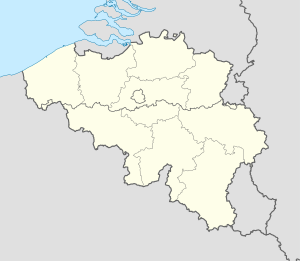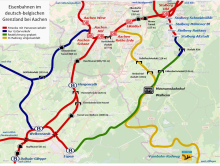Hammerbrücke (Hergenrath)
Coordinates: 50 ° 42 ′ 12 ″ N , 6 ° 2 ′ 50 ″ E
| Hammer bridge | ||
|---|---|---|
| Hammerbrücke with an AM 62-79 railcar in 2007 | ||
| Convicted | Railway line Liège – Aachen | |
| Subjugated | Göhl | |
| place | Hergenrath | |
| Entertained by | Infrabel | |
| overall length | 220 m | |
| Number of openings | 2 | |
| height | 40 m | |
| start of building | 1841 (original viaduct) 1998 (new bridge) |
|
| completion | 1843 (original viaduct) 1999 (new bridge) |
|
| location | ||
|
|
||
The Hammerbrücke near Hergenrath in the north of the German-speaking Community of Belgium is a railway bridge on the Liège – Aachen line over the Göhl .
history
First viaduct
Originally the Göhl valley at Hergenrath was bridged by a brick viaduct, which consisted of 17 two-story arches. Work on this viaduct, which was 220 meters long and 40 meters high, began in 1841. By the time it was completed in 1843, over 8 million stones had been built. The construction costs amounted to 250,000 Prussian thalers. With the opening of the railway line between Aachen and Liège on October 15, 1843, the viaduct was also put into operation.
Destruction in World War II
During the Second World War , the viaduct was blown up by Belgian troops on the night of May 9-10, 1940. A large part of the viaduct was destroyed. Eight Belgian pioneers were killed by the apparently too strong explosive charge .
In the months that followed, the bridge was rebuilt, and numerous prisoners of war were used. The old construction was not restored, instead a steel superstructure was built, which was supported on a single central pillar. When the German troops withdrew, this construction was also blown up on September 12, 1944. Reconstruction began in 1945 and lasted until 1948. The bridge now consisted of two single-track, steel truss bridges , one with an overhead and one with a lower deck.
New building
HSL 3 was opened in 2009 for high-speed traffic between Aachen and Liège . This high-speed route branches off from the old route immediately after the Hammerbrücke and is shared by ICE and Thalys . In order to be able to guarantee safe operation in the future, a new building was built from 1997 to 1999. For this purpose, one of the two structurally separate single-track old bridges was first renovated in 1995 in order to be able to accommodate all traffic during the construction work. In January and February the steel girders of the other bridge were dismantled with a crane and then dismantled, followed by the demolition of the central pillar and the last remaining remains of the wall of the viaduct from 1841. From March 1998, a new central pillar was concreted and the two new ones, 100 each Meter long triangular steel girders installed. In the summer of 1999 the new Hammerbrücke was put into operation, immediately afterwards the dismantling of the second single-track old bridge began, which was completed with the demolition of the central pillar in September 1999. The new hammer bridge is completely welded and designed for speeds of up to 160 km / h.
Individual evidence
- ^ A b c Hans Schweers, Henning Wall: Railways around Aachen: 150 years of the international route Cologne - Aachen - Antwerp. Verlag Schweers + Wall, Aachen 1993, ISBN 3-921679-91-5 , p. 15
- ↑ a b c d The former viaduct (Hammerbrücke) on trois-frontieres.be , accessed on June 20, 2014.
- ↑ a b c d e f The Hammerbrücke near Hauset / Hergenrath on vonderruhren.de , accessed on June 20, 2014.
- ↑ a b The new viaduct (Hammerbrücke) on trois-frontieres.be , accessed on June 20, 2014.


